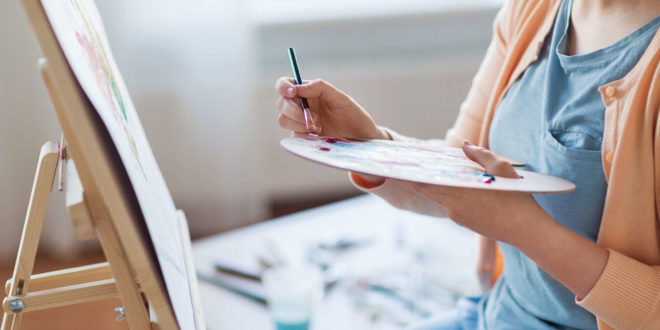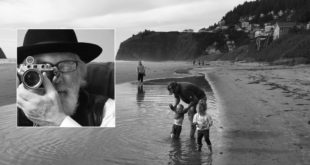Editor – Sylvia, you’ve had a passion for artful things for a long time. Tell us about yourself and your journey into the arts.
Stark – Even as a small child, it never occurred to me that I would ever do anything but art. I drew and painted, made my own paper dolls, and won coloring contests.
I took a year of art at Union College and made straight As in every art course they would allow me to take, but I would have been better off at the Art Institute in Kansas City.
Like every job I ever worked at, I included some artistic aspect, from painting, sculpting, and illustrations until I finally began sign painting on my own, then at a sign shop in Nashville.
While working at the sign shop, I began a side business of my own, doing sandblasted glass, then working my way into stained glass. I left the sign shop after a couple of years, and GlassAct became a 37-year endeavor.
In the back of my mind, I always knew that one day I would paint. A few years ago, I heard that little voice in my head saying, “Sylvia, you’re not getting any younger. Don’t you think you should start now?“ So I said, “Okay.” I sold my glass and took up painting.
Editor – Wow! You felt the pull to be creative at an early age and have explored different mediums over the years. I have several follow-up questions. First of all, tell us more about your work with glass. That’s intriguing.
Stark – At the sign shop where I was working, one of the main types of signs we did was sandblasted redwood signs. Somehow I got to thinking, “I wonder if I could do the same thing on glass, etching 3-D images.“ That turned out beautifully.
I was working out of the sign shop, still full time there, and as word got out among their customers, I began acquiring customers of my own. While there, I traded the use of my equipment with a very talented stained glass artist for tutoring in his craft.
After a couple of years, circumstances necessitated my moving out of the sign shop, and I began working out of my home. I was able to pick up work from contractors and retailers when their clients requested custom work.
When my son was grown, and out of the house, I decided it was time to move to a smaller town. I brought my glass with me. I did some advertising and became rather well-known here, as no one else provided stained glass and stained glass repair. But I guess you can only saturate a small town so much with the one thing, so I eventually sold all my equipment and supplies and decided it was time to start painting. The business of doing stained/leaded glass jobs of any size takes up a whole room in your house. Painting isn’t nearly so expensive in terms of materials and doesn’t take up nearly so much room.
Editor – That is cool you were able to get that experience. Even though you are primarily painting now, I’m sure there are ways that your exposure to glasswork overlaps into your present pursuits. You mentioned stained glass, in addition to glass etching. Please share more about that.
Stark – I have friends who frequently made mission trips to Ecuador to build churches in small towns. One time my good friend came back from a trip and said that a little boy had come up to her and asked her, “Are we going to have stained glass in our church?“ How could she say no to such a precious little guy? So when she got back, I was immediately commissioned to make a small window for their church. I also went on the next mission trip to see it installed. God’s hand was on that window the whole trip down there because it had to be flown in baggage, and the package was smashed on one edge when it got there. With a lot of trepidation as I removed it from its box, I was overjoyed to see the miracle of a window with not one crack in it!
Editor – What a touching moment that must have been! So, now you are painting. Do you use acrylics or oils? And beyond that, what subjects or themes do you most like to paint?
Stark – Pretty much from the start of my “painting phase,” after producing a little inventory, I began doing shows and keeping a wall of work at a gallery in a neighboring town. It shut down after several years, at which point I opened a booth at an art store in my own town. But now, for three or four years, I have kept a wall of my work in a music store downtown. It’s good exposure, and I do a special show there from time to time. Besides my art page on social media, that is basically all the promotion I am doing this time.
I am so very fortunate to live in a part of the country where there are beautiful scenic vistas. Nature inspires me, so landscapes, flowers, and farms find their way into my pictures quite a lot. From time to time, I have ventured to do a portrait or two. The first one I painted was of two local folk/bluegrass musicians, one of whom has a bit of national notoriety. That picture made its way into permanent display in the Museum of Popular Music at a state university near Nashville.
I am working in acrylics at present and am planning at some point to give watercolors a try.
Editor – Do you have any advice for younger artists who are trying to find their niche?
Stark – There are so many directions to go in the art field these days, and some of them require specific training. But no matter the path one chooses, fine arts or the commercial field, it all takes a certain amount of dedication and a good work ethic. You may have an innate talent for art, but nature does not normally hand one anything on a silver platter.
Along the way toward finding one’s special niche, we often have to take work that may not have anything to do, it would seem, towards getting us to our goal. But don’t take your eyes off your goal. If you can dream it, you can achieve it.
Editor – I’m going to ask you one more question that some may wonder why I didn’t make it my first one. But, I would like this thought to be what lingers from our time with you. Why do you create art?
Stark – I’m not sure I have ever thought about the why of making art, so thanks for asking. Creating art is just the natural expression of the desire for beauty and the attempt to convey a sense of the beauty that I feel to others. To have created an object of beauty is a way of creating a sense of joy and peace. I have an extreme sense of satisfaction when something turns out well.
I guess, with that said, creating art, for me, is a very emotional endeavor. When I display my art, I often share a small story about what I was feeling in creating that art, memories encountered. I want to draw other people into my experience. Sometimes they find that very relatable.
The type of painting of other artists that I have enjoyed the most are landscapes, which I would love to step into and start walking through that forest or down that road. If I knew I had instilled just a little bit of that feeling into the dreams of someone else, that would make me very happy.
Editor – We love what you do and your passion for bringing joy into other people’s lives. Thank you!
You can see some of Sylvia’s art on the ASA Gallery Page | Facebook
Sylvia Sioux Stark was interviewed by Rich DuBose, director of ASA.
© 2017 - 2024 ASA. All rights reserved. Click here for content usage information.



